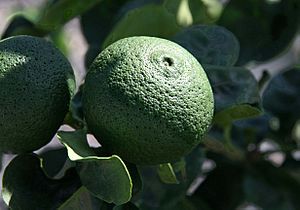Kabosu facts for kids
Quick facts for kids Kabosu |
|
|---|---|
 |
|
| Scientific classification |
Kabosu is a special citrus fruit from an evergreen tree. It's very popular in Japan. People use its juice to make many dishes taste better. It's especially good with cooked fish, sashimi (raw fish), and hot pot meals.
Contents
What is Kabosu Like?
Kabosu is a juicy citrus fruit. It is very similar to another fruit called yuzu. Its juice is quite sour, like a lemon. People often use it instead of vinegar in Japanese cooking.
The fruit grows on a tree that has sharp thorns. Kabosu is usually picked when it is still green. But if you let it stay on the tree, it will turn yellow when it gets ripe. Sometimes, people confuse Kabosu with another fruit called sudachi. However, you can tell Kabosu apart by a small, raised bump at the bottom of the fruit.
Where Does Kabosu Come From?
Kabosu is believed to be a mix of two other citrus fruits. It was brought to Japan from China a long time ago, during the Edo period. It quickly became a popular fruit in Japan.
Most Kabosu in Japan is grown in Ōita Prefecture. You can find many Kabosu trees in places like Taketa and Usuki. In Usuki, there used to be a Kabosu tree that was 300 years old! There are still trees there today that are 200 years old.
How is Kabosu Used?
Kabosu juice is very sour and has a special smell. It is often squeezed over sashimi and grilled fish. It's also used in ponzu sauce for hot pot dishes. In Ōita Prefecture, people even add Kabosu juice to miso soup, noodles, and a drink called shōchū.
To get the juice, you can cut the fruit into quarters. Then, squeeze it with the peel side facing down. This helps stop the seeds from falling into your food or drink.
Kabosu juice is used in many different products. These include sauces, drinks, frozen desserts, snacks, and even pastries.
Did you know? Kabosu can also be used to help fish! When mixed into fish food, special parts of Kabosu stop fish meat from changing color or smelling bad. Fish like Japanese amberjack and Summer flounder that eat this special food are sold as "Kabosu Buri" and "Kabosu Hirame" in Ōita Prefecture.
Where is Kabosu Grown?
Most of the Kabosu in Japan comes from Ōita Prefecture. In fact, Ōita grows about 97% of all the Kabosu in the country! Some other places that grow Kabosu are Aichi Prefecture and Miyazaki Prefecture.
The amount of Kabosu grown can change each year. Some years are "good" years with lots of fruit, and some years have less. The main cities in Ōita that grow Kabosu are Usuki, Ōita, Taketa, Ōita, Bungo-ōno, Ōita, and Kunisaki, Ōita.
Kabosu as a Character
There is a fun mascot character named Kabotan. It looks like a Kabosu fruit! Kabotan was first made for a big gardening fair in Ōita in 2003. After the fair, this character became the official mascot for "Ōita Kabosu." Later, Kabotan started to be used to promote the whole Ōita Prefecture, not just the fruit.
You might also know a famous Shiba Inu dog named Kabosu. This dog is the one from the popular Doge meme on the internet! Her owner named her Kabosu because her face was round, just like the fruit.
See also
 In Spanish: Kabosu para niños
In Spanish: Kabosu para niños


